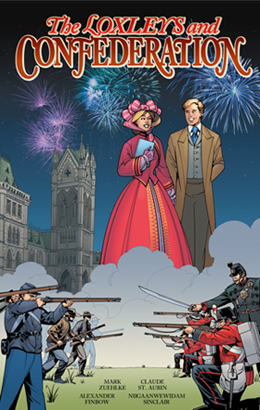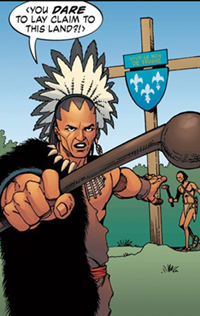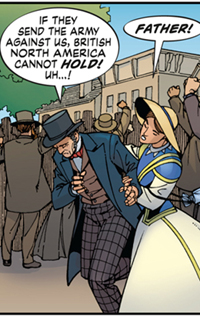| ________________
CM . . .
. Volume XXII Number 1. . . .September 4, 2015

 |
The Loxleys and Confederation.
Mark Zuehlke, Niigaanwewidam James Sinclair & Alexander Finbow. Illustrated by Claude St. Aubin & Christopher Chuckry. Lettering by Todd Klein.
Canmore, AB: Renegade Arts Entertainment Ltd., 2015.
104 pp., hardcover, $19.99.
ISBN 978-0-9921508-9-1.
Subject Heading:
Canada - history- confederation, 1867 - Comic books, strips, etc.
Grades 6-12 / Ages 11-17.
Review by Val Ken Lem.
*** /4
|
| |
|

excerpt:
John A. Macdonald, Granddad said, is a better politician than Mr. Brown, because he can win people over to his view and is a good administrator. George-Étienne Cartier, he says, can win over the French-Canadians in Quebec.
It will be Macdonald and Cartier who will make Confederation work.
It does seem that Mr. Brown is a windbag! I should erase that, but I won’t! Now, I must try and sleep. I will write again very soon. ( From Lillian’s diary).
 Following upon the success of The Loxleys and the War of 1812, a new generation of Loxleys takes on roles that bring Canadian history to life in graphic novel form. In this story, George Loxley is a journalist with the Globe and Mail newspaper owned by George Brown, one of the so-called fathers of Confederation. His daughter, Ruth Stock, is a skilled artist who accompanies her journalist father to sketch scenes that can be reproduced in the newspaper. Lillian, the teenaged daughter of Ruth, is a diarist who accompanies her grandfather and mother as they travel by train in 1864 from Toronto to Montreal with members of the legislative assembly of Upper Canada. In Montreal, the Loxleys are reunited with the prosperous French-Canadian branch of the family including a charming cousin Marc whose function, in part, is as love interest to Lillian. Additional delegates from Lower Canada join the party in Quebec City where they board a vessel destined for Prince Edward Island where the Canadians are to address the members of the maritime colonies that are meeting in Charlottetown to discuss possible political union. The story continues with Lillian, Ruth and George travelling to London at the end of 1866 to cover the British Parliament’s debates on Confederation. Following upon the success of The Loxleys and the War of 1812, a new generation of Loxleys takes on roles that bring Canadian history to life in graphic novel form. In this story, George Loxley is a journalist with the Globe and Mail newspaper owned by George Brown, one of the so-called fathers of Confederation. His daughter, Ruth Stock, is a skilled artist who accompanies her journalist father to sketch scenes that can be reproduced in the newspaper. Lillian, the teenaged daughter of Ruth, is a diarist who accompanies her grandfather and mother as they travel by train in 1864 from Toronto to Montreal with members of the legislative assembly of Upper Canada. In Montreal, the Loxleys are reunited with the prosperous French-Canadian branch of the family including a charming cousin Marc whose function, in part, is as love interest to Lillian. Additional delegates from Lower Canada join the party in Quebec City where they board a vessel destined for Prince Edward Island where the Canadians are to address the members of the maritime colonies that are meeting in Charlottetown to discuss possible political union. The story continues with Lillian, Ruth and George travelling to London at the end of 1866 to cover the British Parliament’s debates on Confederation.
 Historian Mark Zuehlke is the lead writer and manages to embed a tremendous amount of historical details into the comic. Readers will discover factors, such as fear of American annexation, the end of free trade with the American nation, and the threat of Fenian raids, that contributed to the growing interest in a union of the remaining British colonies in America. Details are uncovered in the course of conversations between characters as well as through diary entries and letters written by Ruth to Lillian. The events are reinforced at the end of the work in an extended diary consisting of Lillian’s entries for September 1867. Claude St. Aubin’s illustrations pay attention to historic details. Colourist Christopher Chuckry employs a vibrant palette for current action and a more subdued scheme to indicate when characters are recalling events from their pasts. The smoke-filled interior of a passenger train is a masterful example of illustrator and colourist working in harmony. Todd Klein’s lettering is first rate as one expects from this master of his craft. Historian Mark Zuehlke is the lead writer and manages to embed a tremendous amount of historical details into the comic. Readers will discover factors, such as fear of American annexation, the end of free trade with the American nation, and the threat of Fenian raids, that contributed to the growing interest in a union of the remaining British colonies in America. Details are uncovered in the course of conversations between characters as well as through diary entries and letters written by Ruth to Lillian. The events are reinforced at the end of the work in an extended diary consisting of Lillian’s entries for September 1867. Claude St. Aubin’s illustrations pay attention to historic details. Colourist Christopher Chuckry employs a vibrant palette for current action and a more subdued scheme to indicate when characters are recalling events from their pasts. The smoke-filled interior of a passenger train is a masterful example of illustrator and colourist working in harmony. Todd Klein’s lettering is first rate as one expects from this master of his craft.
 Niigaanwewidam James Sinclair is a secondary author who is responsible for the “Afterword: Looking for Kanata” that reminds readers that, when Jacques Cartier claimed what became New France for the King of France, he was claiming a land that was already peopled by many First Nations. Injustices meted out to Canada’s aboriginal peoples is a subtheme that appears throughout the work, beginning with a prologue on Cartier in the 16th century, long before the Confederation tale begins in 1864. George Loxley, in particular, is appalled by the treatment of Indians and possibly reflects more 21st century than 19th century views. Nevertheless, it is refreshing to find a challenge to the old-fashioned narrative that Canada was created by two founding nations, Anglo and French. One of Sinclair’s lines rings especially true in modern thinking: “Cartier was probably the worst house guest anyone could ever have.” Niigaanwewidam James Sinclair is a secondary author who is responsible for the “Afterword: Looking for Kanata” that reminds readers that, when Jacques Cartier claimed what became New France for the King of France, he was claiming a land that was already peopled by many First Nations. Injustices meted out to Canada’s aboriginal peoples is a subtheme that appears throughout the work, beginning with a prologue on Cartier in the 16th century, long before the Confederation tale begins in 1864. George Loxley, in particular, is appalled by the treatment of Indians and possibly reflects more 21st century than 19th century views. Nevertheless, it is refreshing to find a challenge to the old-fashioned narrative that Canada was created by two founding nations, Anglo and French. One of Sinclair’s lines rings especially true in modern thinking: “Cartier was probably the worst house guest anyone could ever have.”
While The Loxleys and Confederation will appeal to young readers, including reluctant readers who may be more comfortable with a graphic novel rather than a more text-heavy history-based work, the didactic elements of the work and efforts to incorporate the subtheme of injustice to Canada’s first nations often seems forced and the narrative arc of the work suffers.
In order to maximize use of the book, libraries may be wise to classify this work with Canadian history rather than a graphic arts number for drawings.
Recommended.
Val Ken Lem is a collections librarian at Ryerson University in Toronto, ON.

To comment
on this title or this review, send mail to cm@umanitoba.ca.
Copyright © the Manitoba Library Association. Reproduction for personal
use is permitted only if this copyright notice is maintained. Any
other reproduction is prohibited without permission.
Next Review | Table of Contents For This Issue - September 4, 2015
CM Home | Back Issues
| Search
| CM Archive
| Profiles Archive
|

 Following upon the success of
Following upon the success of  Historian Mark Zuehlke is the lead writer and manages to embed a tremendous amount of historical details into the comic. Readers will discover factors, such as fear of American annexation, the end of free trade with the American nation, and the threat of Fenian raids, that contributed to the growing interest in a union of the remaining British colonies in America. Details are uncovered in the course of conversations between characters as well as through diary entries and letters written by Ruth to Lillian. The events are reinforced at the end of the work in an extended diary consisting of Lillian’s entries for September 1867. Claude St. Aubin’s illustrations pay attention to historic details. Colourist Christopher Chuckry employs a vibrant palette for current action and a more subdued scheme to indicate when characters are recalling events from their pasts. The smoke-filled interior of a passenger train is a masterful example of illustrator and colourist working in harmony. Todd Klein’s lettering is first rate as one expects from this master of his craft.
Historian Mark Zuehlke is the lead writer and manages to embed a tremendous amount of historical details into the comic. Readers will discover factors, such as fear of American annexation, the end of free trade with the American nation, and the threat of Fenian raids, that contributed to the growing interest in a union of the remaining British colonies in America. Details are uncovered in the course of conversations between characters as well as through diary entries and letters written by Ruth to Lillian. The events are reinforced at the end of the work in an extended diary consisting of Lillian’s entries for September 1867. Claude St. Aubin’s illustrations pay attention to historic details. Colourist Christopher Chuckry employs a vibrant palette for current action and a more subdued scheme to indicate when characters are recalling events from their pasts. The smoke-filled interior of a passenger train is a masterful example of illustrator and colourist working in harmony. Todd Klein’s lettering is first rate as one expects from this master of his craft. Niigaanwewidam James Sinclair is a secondary author who is responsible for the “Afterword: Looking for Kanata” that reminds readers that, when Jacques Cartier claimed what became New France for the King of France, he was claiming a land that was already peopled by many First Nations. Injustices meted out to Canada’s aboriginal peoples is a subtheme that appears throughout the work, beginning with a prologue on Cartier in the 16th century, long before the Confederation tale begins in 1864. George Loxley, in particular, is appalled by the treatment of Indians and possibly reflects more 21st century than 19th century views. Nevertheless, it is refreshing to find a challenge to the old-fashioned narrative that Canada was created by two founding nations, Anglo and French. One of Sinclair’s lines rings especially true in modern thinking: “Cartier was probably the worst house guest anyone could ever have.”
Niigaanwewidam James Sinclair is a secondary author who is responsible for the “Afterword: Looking for Kanata” that reminds readers that, when Jacques Cartier claimed what became New France for the King of France, he was claiming a land that was already peopled by many First Nations. Injustices meted out to Canada’s aboriginal peoples is a subtheme that appears throughout the work, beginning with a prologue on Cartier in the 16th century, long before the Confederation tale begins in 1864. George Loxley, in particular, is appalled by the treatment of Indians and possibly reflects more 21st century than 19th century views. Nevertheless, it is refreshing to find a challenge to the old-fashioned narrative that Canada was created by two founding nations, Anglo and French. One of Sinclair’s lines rings especially true in modern thinking: “Cartier was probably the worst house guest anyone could ever have.”